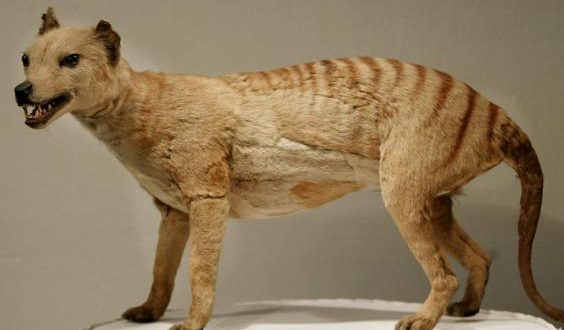Scientists are launching a search for the extinct Tasmanian tiger (Thylacine) in Far North Queensland after a number of sightings were reported.
Researchers will set up more than 50 camera traps in the remote Cape York Peninsula in the hope of spotting Tasmanian tigers, a species which was declared extinct in 1936.
There is no doubt that the wolf-like Tasmanian tigers once existed on the Australian mainland as physical remains (both fossils and non-fossils) have been found and Aboriginal rock art also features the animal.
Brian Hobbs, a former tourism operator, revealed a few weeks ago that he’d seen a family of Tasmanian tigers in 1983 when he was walking his dog at night while on a camping trip. Hobbs says he saw the animals clearly in his flashlight from about 20 feet away.
“These animals, I’ve never seen anything like them before in my life,” he told Australia’s ABC news network.
“They were dog-shaped — I had a shepherd with me so I certainly know what dogs are about — and in the spotlight I could see they were tan in color and they had stripes on their sides.”
The other credible sighting was by former Park Ranger Patrick Shears, who says not only has he seen a Tasmanian tiger, but that Aboriginal people in the area see them frequently.
“They pretty well confirmed that they know about a dog-like creature — not a dingo — that’s often seen at night,” he said, the Telegraph reports. “They call it the ‘moonlight tiger’… They’re curious. If you’re not moving and not making a noise they’ll come within a reasonable range and check you out then just trot off.”
Professors Bill Laurance and Sandra Abell of James Cook University will lead the search for the animals in Cape York, in northeastern Australia. Fifty camera traps will be set up in the region in hopes of documenting the officially extinct animal’s existence.
Laurance told ABC he finds Hobb’s sighting especially solid.
“We have cross-checked the descriptions we received of eye shine color, body size and shape, animal behavior, and other attributes, and these are inconsistent with known attributes of other large-bodied species in north Queensland such as dingoes, wild dogs or feral pigs,” he told the Telegraph.
Though admittedly it would be very unlikely for the species to have survived at such low numbers as to escape detection, “You learn in science to never say never [because] every time we think we know everything it turns around and bites us on the backside,” Laurance told ABC.
Although commonly called the Tasmanian Tiger or Tasmanian Wolf, the thylacine has more in common with its marsupial cousin the Tasmanian Devil. With a head like a wolf, striped body like a tiger and backward facing pouch like a wombat, the thylacine was as unbelievable as the platypus which had caused disbelief and uproar in Europe when it was first described.
The thylacine looked like a long dog with stripes, a heavy stiff tail and a big head. A fully grown thylacine could measure 180cm from the tip of the nose to the tip of the tail, stand 58cm high at the shoulder and weigh about 30 kilograms. It had short, soft fur that was brown except for the thick black stripes which extended from the base of the tail to the shoulders.
Abell told ABC time is of the essence in the Tassie tiger hunt.
“We have had declines in our mammals all through Cape York and through Australia, so my concern is that if we leave it too much longer to just go and have a look then we could actually miss out on seeing something,” she said.
And though the odds are long, this wouldn’t be the first time camera traps found a species thought to be extinct in Cape York: “We’ve just rediscovered a population of northern bettong where there had been no records since 2003,” Abell pointed out.
The survey will also help collect general information about species in Cape York, an area on which relatively little data has been collected, the researchers say.
The Telegraph points out that scientists in Australia have been attempting to clone the Tasmanian tiger, and that Tasmanian tour operator Stuart Malcolm has offered an $1.3 million for proof the animals exist today.
Agencies/Canadajournal
 Canada Journal – News of the World Articles and videos to bring you the biggest Canadian news stories from across the country every day
Canada Journal – News of the World Articles and videos to bring you the biggest Canadian news stories from across the country every day



